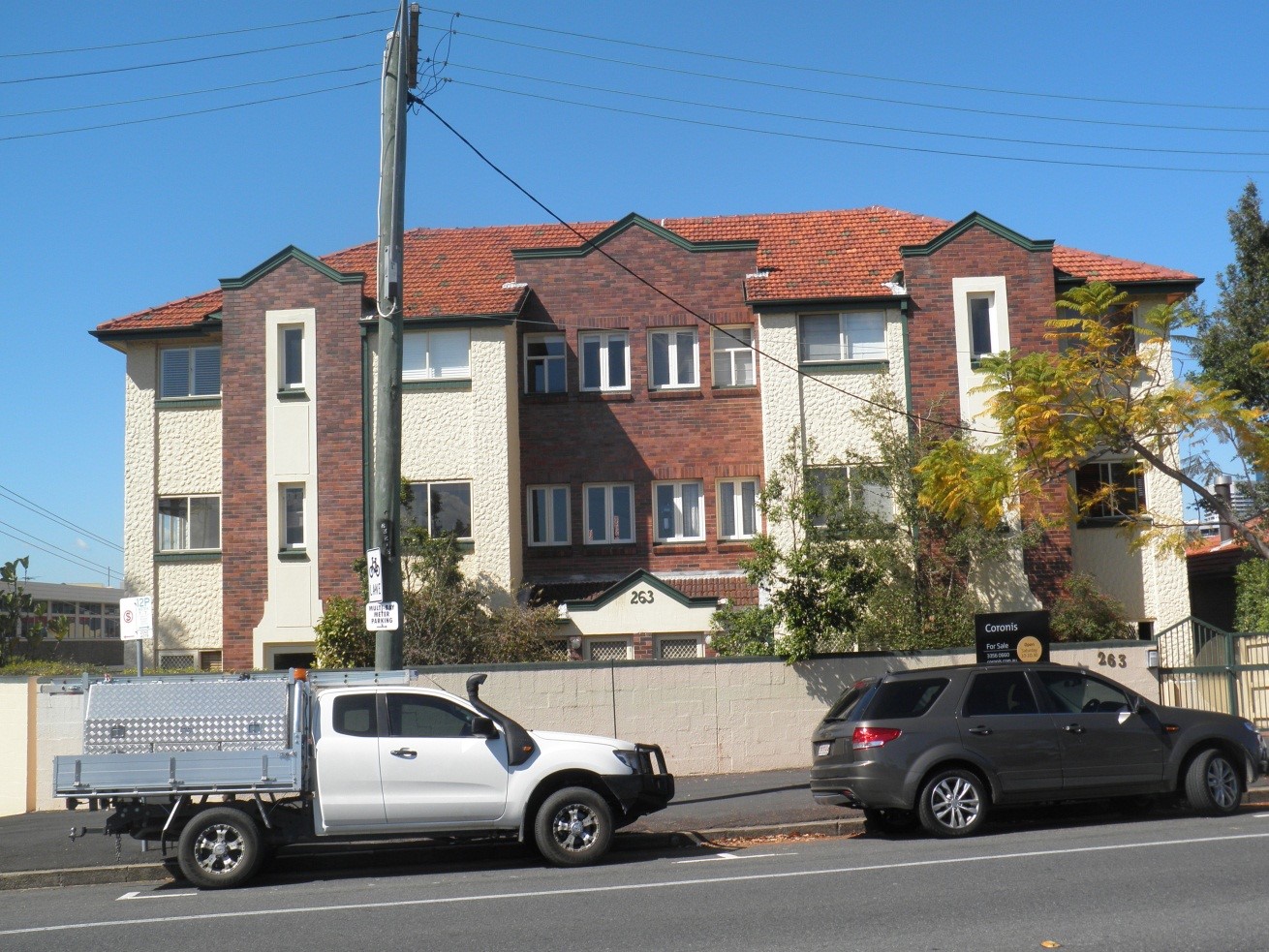Addresses
Type of place
Flat building
Period
Interwar 1919-1939
Style
Spanish Mission
Addresses
Type of place
Flat building
Period
Interwar 1919-1939
Style
Spanish Mission
The set of six flats on the corner of Gregory Terrace and Victoria Street was constructed between 1935 and 1936. They were built for Walter Tiplady as an investment property and were designed by prominent Brisbane architect, George Rae. 263 Gregory Terrace is important in demonstrating Brisbane’s development pattern in the interwar period, in particular in Spring Hill, and the way in which ideas about acceptable forms of housing were changing.
Lot plan
Key dates
Local Heritage Place Since —
Date of Citation —
Construction
Roof: Terracotta tile;Walls: Masonry
People/associations
George Rae (Architect)Criterion for listing
(A) Historical; (E) AestheticInteractive mapping
Lot plan
Key dates
Local Heritage Place Since —
Date of Citation —
Construction
Roof: Terracotta tile;Walls: Masonry
People/associations
George Rae (Architect)Criterion for listing
(A) Historical; (E) AestheticInteractive mapping
History
As the Great Depression progressed in the late 1920s and into the 1930s a marked deficit of housing in Brisbane emerged. This was the period in which the multi-unit dwelling began to emerge as an alternative to the traditional Brisbane house and yard. Prior to this in larger Australian cities such as Sydney and Melbourne this style of ‘modern’ living, in blocks of flats, had become a stylish alternative to living in the traditional house.
In the early 1930s to cater for the housing shortage as well as to generate income many home owners in the inner-city suburbs converted houses into tenements, where tenants would share bathrooms, toilets and kitchens. This led to community concerns of overcrowding and increased hygiene problems. A fashionable and more sophisticated alternative to this form of accommodation was the purpose built block of self-contained flats. Marketed mainly at single people and childless couples the earliest self-contained flats in Brisbane were generally conveniently situated close to trams, trains and shopping facilities in inner-city suburbs such as Spring Hill, New Farm and Fortitude Valley.
The Brisbane City Council, in 1930, defined the flat as “a fully self-contained dwelling, with private kitchen, bathroom and water closet”. The flat was designed to be an independently functioning dwelling. Although seen as a sophisticated lifestyle, flat living was fairly uncommon in Brisbane in this period, with only 8.4% of Brisbane residents living in flats. This low percentage may be due to the economic constraints of the time as well as the perceived novelty of this style of living. Most interwar flats in Brisbane were architecturally designed and constructed from good quality brick and timber.
In 1935 Walter Barry Tiplady, an auctioneer, purchased one rood and twenty-one perches of land on the corner of Gregory Terrace and Victoria Street, Spring Hill. Tiplady commissioned successful Brisbane architect, George Rae, to design a new set of flats as an investment property. In July 1935, Rae invited tenders for the construction of the flats and builder, S Conwell was awarded the contract.
As one of Brisbane’s most successful architects in the interwar period, George Rae had first established his own architectural firm in 1933. Prior to this he had been employed at the larger Brisbane firm of Atkinson, Conrad and Powell. Rae was renowned for designing modern buildings in Brisbane during the interwar period such as multi-unit residential buildings which were a very new idea at this time.
By May 1936, the building had been completed and tenants began to rent the flats. The modern design of the flats was featured in an article in the Sunday Mail in May 1936. It was stated that:
These flats are the very latest in modern design and construction, extensively planned and detailed… built of brick and concrete, with wooden floors…Each flat consist of two bedrooms, living room, sleep out, breakfast room, kitchen, bathroom, and front veranda. All rooms are plaster ceiled, with ceilings of ornate design… Mock fire-places have been built in each living room.1
263 Gregory Terrace is important in demonstrating Brisbane’s development pattern in the interwar period, in particular in Spring Hill, and the way in which ideas about acceptable forms of housing were changing.
Description
Chiverton Flats is a three-storey plus basement, masonry apartment building fronting Gregory Terrace, Spring Hill with side frontage to Victoria Street. It has a terracotta tile hipped roof and a rendered exterior with face brick elements. It retains some original timber framed casement windows. Verandahs have been enclosed. Garages are in the basement.
Statement of significance
Relevant assessment criteria
This is a place of local heritage significance and meets one or more of the local heritage criteria under the Heritage planning scheme policy of the Brisbane City Plan 2014. It is significant because:
References
-
Sunday Mail, 3 May 1936, p9
-
Brisbane City Council Minutes, 1935-36, p.764 & 918 and 1938, p.605
-
Brisbane City Council, 1946 aerial photographs.
-
Brisbane City Council Metropolitan Water Supply and Sewerage Board, Detail Plans
-
Certificates of Title, Department of Environment and Resource Management
-
McKellar's Map of Brisbane and Suburbs. Brisbane: Surveyor-General’s Office, 1895
-
Queensland Post Office Directories
-
Queensland Electoral Rolls
-
Brisbane City Council, Register of New Buildings, 1933
-
Australia Birth Index, 1899
-
Bennett, Helen, “Being Modern: Living in Flats in Interwar Brisbane”, Queensland Review, v.13, no.2, 2006, p35-48
-
Nambour Chronicle and North Coast Advertiser, 4 October 1940, p9
-
A&B Journal of Queensland, 10 July, 1935, p23
Citation prepared by — Brisbane City Council (page revised September 2020)

